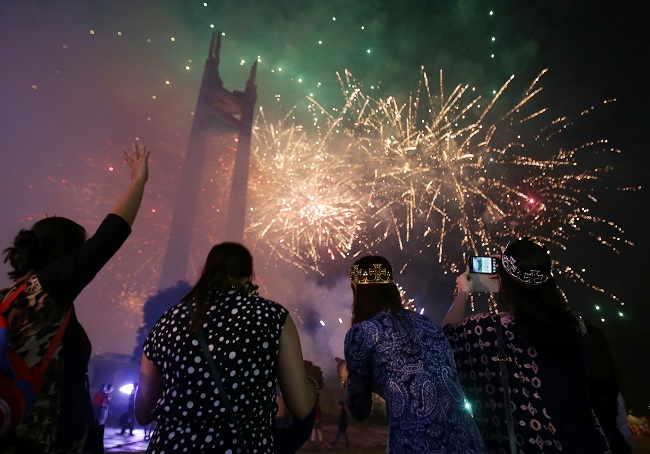Filipinos hopeful of getting their groove back

Spectators watch a fireworks display during a New Year’s celebration at the Quezon Memorial Circle in suburban Quezon city, north of Manila, Philippines on Thursday, Jan. 1, 2015. AP
Nine in 10 Filipinos are looking at 2015 with hope, according to a recent poll. But is there really any reason to hope? Perhaps.
The Philippines will bracket 2015 with two big events.
Pope Francis will visit the Philippines later this month, and the world’s leaders will descend on the nation for the Apec summit in November.
In between, there is the economy and an election frenzy.
Third-quarter growth data suggests a much sobering end to last year from the previous narrative of an “Asian economic miracle”.
The economy grew by just 5.3 per cent in the third quarter, its slowest pace since 2011.
But this is not fatal.
Two of the biggest culprits for the slowdown are reversible: government underspending and a massive congestion at Manila’s main ports.
Due to a corruption scandal that ensnared a special mechanism President Benigno Aquino had been using to hasten disbursement of public funds to his priority projects, the government spent 1.46 trillion pesos (US$32.52 billion) in the first nine months of last year, 16 per cent less than its target.
“It was mainly the government itself that induced the economy’s slowdown,” said Cielito Habito, who was economic planning minister under former president Fidel Ramos.
It did not help that the nation’s main ports were crippled for months by a truck ban. A Citigroup economist placed the economic cost at 350 billion pesos.
These kinks, however, have been sorted out. Economic Planning Minister Arsenio Balisacan said the government has adjusted to “new protocols” in fund disbursement, and the truck ban was lifted in September.
Said Habito: “I continue to believe that the economy, in spite of government missteps, has attained a new growth trajectory that could hold for a long time, especially if the government finally gets its act together.”
Credit Agricole said it expects the Philippines to get its groove back this year and post growth of up to 7.3 per cent.
The government will continue to spend, the nation’s migrant workers will still remit billions in foreign currencies to fuel consumer spending, and the Philippines will see money from a seasonal source: the elections.
The new year will lead in to an election year. That usually means campaign kitties will begin unleashing billions’ worth of funds built up since the last general election in 2010.
“Much of the money comes into circulation out of bank accounts being held here and abroad, hidden or unhidden. It also comes out of government coffers or from underneath mattresses, and treasure chests or even from illegal money-printing machines,” said Habito.
Economists said elections unleash about 13.5 billion pesos and create some 1.5 million jobs.
But there are potholes in an otherwise paved road.
There is China, for instance.
The Philippines expects a United Nations court to rule by the year end on a case it filed challenging China’s claims to nearly all of the resource-rich but politically divisive South China Sea.
Either way the ruling blows, relations between the two countries are bound to be tested again after a slight thaw late last year.
Fortunately, the Apec summit that Manila will host in November should prevent disagreements from spiralling out of control.
China’s President Xi Jinping will attend the summit. It is hoped that there will be a repeat of the “meeting of minds” that took place between him and Aquino at last year’s summit.
Then, there is Abu Sayyaf.
Security officials said the Muslim extremist group was able to attract more followers last year after a spate of high-profile kidnappings that brought in millions in ransom. An Abu Sayyaf cell reportedly received 250 million pesos after releasing two German hostages last November.
Though still regarded as a fringe group, Abu Sayyaf now has enough cash to create trouble here and, with its professed ties to ISIS and Malaysia’s Jemaah Islamiah, abroad.
Still, it does not take much to raise hope in the Philippines. The Pope’s visit alone will spread enough goodwill in this nation of 80 million devout Catholics.
That may be more than enough to keep the nation on an even keel as it enters a year that may bring uncertainties, with the Aquino administration bowing out.
RELATED STORIES
